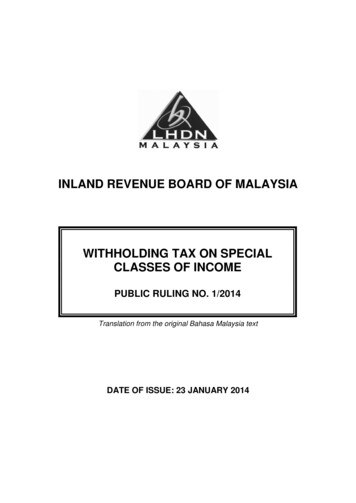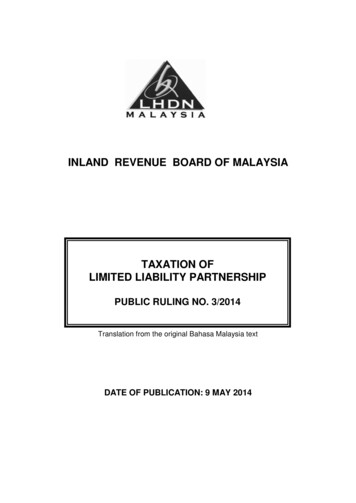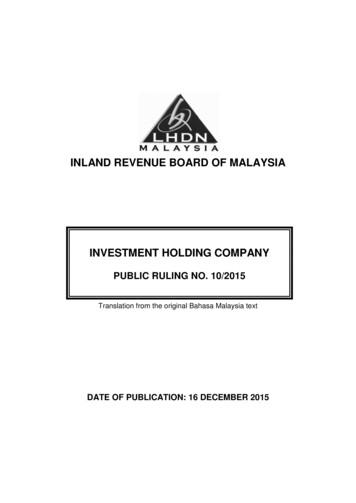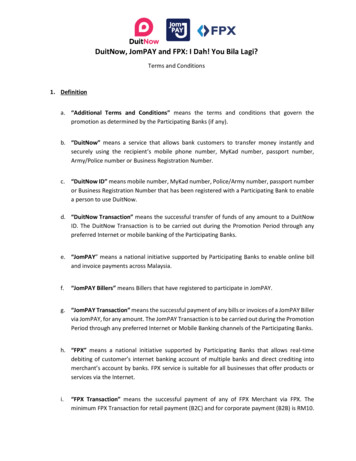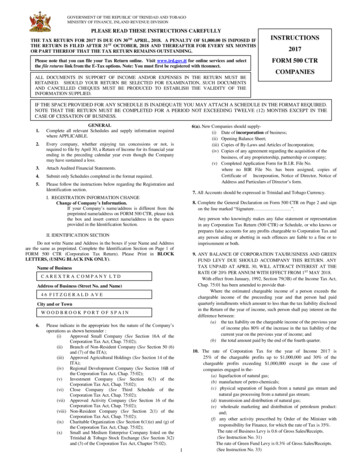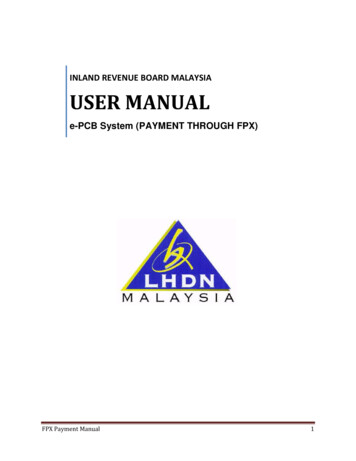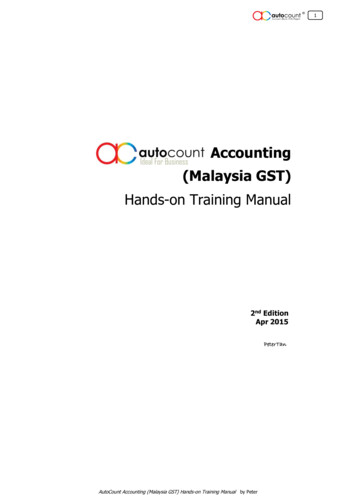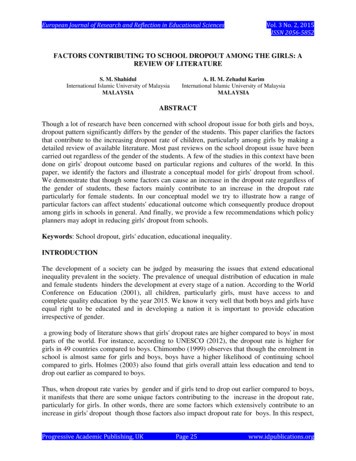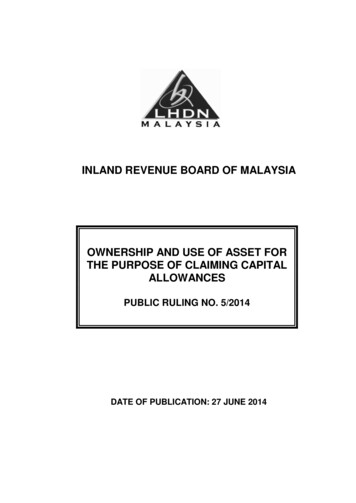
Transcription
INLAND REVENUE BOARD OF MALAYSIAOWNERSHIP AND USE OF ASSET FORTHE PURPOSE OF CLAIMING CAPITALALLOWANCESPUBLIC RULING NO. 5/2014DATE OF PUBLICATION: 27 JUNE 2014
OWNERSHIP AND USE OF ASSETFOR THE PURPOSE OF CLAIMINGCAPITAL ALLOWANCESINLAND REVENUE BOARD OF MALAYSIAPublished byInland Revenue Board of MalaysiaPublished on 27 June 2014First edition on 27 June 2014(This Public Ruling replaces the Public RulingNo. 1/2001 dated 18.01.2001 issued by theInland Revenue Board of Malaysia.) Inland Revenue Board of MalaysiaAll rights reserved on this Public Ruling . Oneprint or electronic copy may be made forpersonal use. Professional firms andassociations are permitted to use the PublicRuling for training purposes only. Systemicor multiple reproduction, distribution tomultiple location via electronic or othermeans, duplication of any material in thisPublic Ruling for a fee or commercialpurposes, or modification of the content ofthe Public Ruling are prohibited.Public Ruling No. 5/2014Date Of Publication: 27 June 2014
OWNERSHIP AND USE OF ASSETFOR THE PURPOSE OF CLAIMINGCAPITAL ALLOWANCESINLAND REVENUE BOARD OF MALAYSIACONTENTSPublic Ruling No. 5/2014Date Of Publication: 27 June 2014Page1.Objective12.Summary Of Changes13.Relevant Provisions Of The Law24.Interpretation25.Application Of Relevant Law36.Ownership Of The Asset47.Jointly Owned Asset78.Partnership Asset89.Limited Liability Partnership Asset1110. Hire Purchase Asset1211. Leased Asset2012. Business Trust Asset2213. Use Of Asset2314. Asset Classified As Held For Sale2715. Procedure For Claiming Capital Allowances28DIRECTOR GENERAL'S PUBLIC RULINGSection 138A of the Income Tax Act 1967 [ITA] provides that Director General isempowered to make a public ruling in relation to the application of anyprovisions of ITA.A Public Ruling is published as a guide for the public and officers of the InlandRevenue Board of Malaysia. It sets out the interpretation of the Director Generalof Inland Revenue in respect of the particular tax law and the policy as well asthe procedure applicable to it.The Director General may withdraw either wholly or in part, by notice ofwithdrawal or by publication of a new ruling.Director General of Inland Revenue,Inland Revenue Board of Malaysia.
OWNERSHIP AND USE OF ASSET FORTHE PURPOSE OF CLAIMINGCAPITAL ALLOWANCESPublic Ruling No. 5/2014Date Of Publication: 27 June 2014INLAND REVENUE BOARD OF MALAYSIA1.ObjectiveThe objective of this Public Ruling (PR) is to explain the ownership and use of assetand the effect on whether a person qualifies to claim capital allowances (CA) inrespect of that asset in determining the statutory income from a business of theperson.2.Summary Of ChangesThis PR is published to replace the Public Ruling No.1/2001 issued on 18.1.2001 withthe following amendments:Changes In This RulingParagraph In PublicRuling No. 1/2001ParagraphItem11Objective23Relevant Provisions of theLaw5Application of relevant law6Ownership of the asset7Jointly owned asset8Partnership asset4Interpretation2Summary of changes9Limited LiabilityPartnership asset10Hire purchase asset11Leased asset12Business Trust asset13Use of asset14Asset classified as HeldFor Sale15Procedure for claimingcapital allowances34NoneReferenceParagraphshave beenreplaced andrearrangedNewparagraphsinsertedPage 1 of 28
OWNERSHIP AND USE OF ASSET FORTHE PURPOSE OF CLAIMINGCAPITAL ALLOWANCESINLAND REVENUE BOARD OF MALAYSIA3.4.Public Ruling No. 5/2014Date Of Publication: 27 June 2014Relevant Provisions Of the Law3.1This PR takes into account laws which are in force as at the date this PR ispublished.3.2The Provisions of the Income Tax Act 1967 (ITA) related to this PR aresubsections 2(1), 2(8), section 42 and schedule 3.3.3Relevant subsidiary laws referred to in this PR is P.U.(A) 131/1986.InterpretationThe words used in this PR have the following meanings:4.1“Asset” means plant and machinery used for business purposes andqualifiying expenditure has been incurred.4.2“Special Purpose Asset” means a leased asset where no other user can usethe same asset without making alterations or dismantling from a structure orland and shall be deemed to be a movable property.4.3“Business Trust” means a unit trust scheme where the operation ormanagement of the scheme and the scheme’s property or asset is managedby a trustee-manager.4.4“Balancing Allowance” refers to the difference where the disposal value of anasset is less than the residual expenditure.4.5“Balancing Charge” ” refers to the difference where the disposal value of anasset is more than the residual expenditure.4.6“Plant” for the purpose of qualifiying expenditure means any movable orimmovable assets including whatever apparatus is used in a business butdoes not include stock-in-trade and premise where the business isconducted.4.7“Disposed” means an asset is sold, discarded or destroyed or it ceased to beused for the purposes of the business.4.8“Market Value” means the price for the goods sold in a transaction betweenindependent persons dealing at arm’s length.4.9“Person” includes a company, a body of persons, a limited liability partnershipand a corporation sole.4.10“Lease” includes a sublease, a tenancy for three years or less and anyagreement for a lease or sublease.Page 2 of 28
OWNERSHIP AND USE OF ASSET FORTHE PURPOSE OF CLAIMINGCAPITAL ALLOWANCESINLAND REVENUE BOARD OF MALAYSIA5.Public Ruling No. 5/2014Date Of Publication: 27 June 20144.11“Partnership” means an association of any kind (including joint adventures,syndicates and cases where a party to the association is itself a partnership)between parties who have agreed to combine any of their rights, powers,property, labour or skill for the purpose of carrying on a business and sharingthe profits therefrom, but excludes a Hindu Joint Family although such afamily may be a partner in a partnership or a limited liability partnership.4.12“Qualifying Expenditure” means capital expenditure incurred on the provision,construction or purchase of plant or machinery used for the purpose of abusiness other than assets that have an expected life span of not more than2 years.4.13“Limited Liability Partnership” means a limited liability partnership registeredunder the Limited Liability Partnerships Act 2012.4.14“Company” means a body corporate and includes any body of personsestablished with a separate legal identity by or under the laws of territoryoutside Malaysia and a business trust.4.15"Year of Assessment" means calendar year.4.16"Basis year for a year of assessment" means the calendar year coincidingwith the year of assessment.4.17“Lease Term” means the period for which the lessee has contracted to leasean asset or where a lease arrangement has been terminated earlier than itsexpiry the actual period of the lease.Application Of Relevant LawIn determining the adjusted income of a business, no deduction is allowed forexpenses incurred on an asset and depreciation charged in the accounts. However, ifthe expenditure is qualifying expenditure (QE) [expenditure on plant and machinery] atax deduction is given in the form of capital allowance (CA) in determining thestatutory income from a business source as provided under section 42 of the ITA.CA is only given to the person who incurred the QE on an asset used in his businessas provided under Schedule 3 of the ITA and would only be allowed a deduction ifclaimed.CA is given in the form of initial allowance (IA) and annual allowance (AA).5.1Eligibility for Initial AllowanceA person has to satisfy the following conditions in order to qualify for IA inrespect of an asset for a year of assessment:Page 3 of 28
OWNERSHIP AND USE OF ASSET FORTHE PURPOSE OF CLAIMINGCAPITAL ALLOWANCESINLAND REVENUE BOARD OF MALAYSIA5.2Public Ruling No. 5/2014Date Of Publication: 27 June 2014(a)was carrying on a business during the basis period,(b)had incurred QE during the basis period, and(c)at the end of the basis period (or, if the asset was disposed of, at thetime of disposal), he was the owner of the asset.Eligibility for Annual AllowanceA person has to satisfy the following conditions in order to qualify for AA inrespect of an asset for a year of assessment:6.(a)was carrying on a business during the basis period,(b)had incurred QE during the basis period,(c)that asset was used for the purpose of the business, and(d)at the end of the basis period, he was the owner of the asset and theasset was in use.Ownership Of The AssetOwnership of an asset in this PR refers to either legal or beneficial ownership. Theperson who owns an asset can be the legal or beneficial owner or both.6.1Legal ownershipLegal owner is the person whose name is registered or documented as proofof ownership.Example 1For landed asset – the person whose name is on the land grant.For motor vehicle – the person whose name is on the vehicle card.For machinery – the person whose name is on the warranty certificate orinsurance policy.6.2Beneficial ownershipBeneficial owner is the person who has actually incurred the QE and paymentfor the asset that can be proved in the books of accounts with supportingdocuments such as invoices, vouchers and receipts.For the purposes of schedule 3 of the ITA, if a beneficial owner has incurredthe QE and used the asset for his business, he is entitled to claim CAPage 4 of 28
OWNERSHIP AND USE OF ASSET FORTHE PURPOSE OF CLAIMINGCAPITAL ALLOWANCESINLAND REVENUE BOARD OF MALAYSIAPublic Ruling No. 5/2014Date Of Publication: 27 June 2014although the asset is registered in the name of another person (the legalowner).Example 2Akmal purchased a lorry in 2013 and registered it in the name of his brother,Ahmad. Akmal paid the installments and used the lorry for his business untilthe end of the basis period for the year of assessment 2013.Akmal is the beneficial owner as he has incurred the QE and the lorry wasused for the purpose of his business. Therefore Akmal is entitled to claim IAand AA on the lorry for the year of assessment 2013. Ahmad is not entitled toclaim CA as he has not incurred the QE.6.3Legal owner who incurs qualifying expenditureA legal owner who incurs the QE is also the beneficial owner. If the assetowned is used in his business, the owner is entitled to claim CA.Example 3Maniam purchased a van on HP and registered it in his name. He uses thevan in his grocery business.Maniam is entitled to claim CA as he has fulfilled the conditions stated inparagraphs 5.1 and 5.2 of this PR.Example 4Airina Food Sdn Bhd (AF) is a supplier and distributor of ice cream, dairyproducts and other frozen foods. AF purchased a few units of freezers andput them in retail outlets and supermarkets without charging any rent on thecondition that the retailers and supermarket owners sell only frozen goodssupplied by AF.Although the assets are placed in the customers’ premises, the assets arebeing used for the purpose of AF’s business. Thus, AF is entitled to claim CAon the assets as AF is the legal and beneficial owner and has satisfied all theconditions stated in paragraphs 5.1 and 5.2 of this PR.Example 5Syarikat Insurans Ally (Ally) provided assets such as computers and furnitureto its insurance agents for use in premises rented by Ally.Although the assets are placed in the premises and used by Ally’s insuranceagents, the assets are being used for the purpose of Ally’s business.Therefore Ally is the legal and beneficial owner of the assets and is entitled toPage 5 of 28
OWNERSHIP AND USE OF ASSET FORTHE PURPOSE OF CLAIMINGCAPITAL ALLOWANCESINLAND REVENUE BOARD OF MALAYSIAPublic Ruling No. 5/2014Date Of Publication: 27 June 2014claim CA as Ally has satisfied all the conditions stated in paragraphs 5.1 and5.2 of this PR.6.4Legal owner who does not incur qualifying expenditureA legal owner who does not incur the QE even though he uses the asset forthe purpose of his business, is not entitled to claim CA as he has not fulfilledall the conditions stated in paragraphs 5.1 and 5.2 of this PR.Example 6Ungu Sdn Bhd, a construction company, is the legal owner of a lorry which ispurchased by its holding company. The lorry is used by Ungu to transportconstruction materials. The holding company pays the monthly installmentsand is responsible for the maintenance of the lorry.Though Ungu is the legal owner of the lorry, it is not entitled to claim CA onthe lorry as it did not incur the QE even though the lorry is used in itsbusiness.6.5Beneficial owner incurs the qualifying expenditure but asset is not usedin his businessThe QE is incurred by the beneficial owner but the asset is not used for thepurposes of his business, instead the asset is being used by the legal owneror some other person. The beneficial owner is not eligble to claim CA as hehas not fulfilled the conditions stated in paragraphs 5.1 and 5.2 of this PR.Example 7Same facts as in Example 6.The holding company is the beneficial owner as it has incurred the QE.However, the holding company is not entitled to claim CA on the lorry as thelorry is not used in its business, but being used by the legal owner.Example 8MM Sdn Bhd (MMSB) carries on a business on the import of crystals. MMSBwould order from its supplier based on orders received from MM MarketingSdn Bhd. MM Marketing and the supplier are associated companies ofMMSB.MMSB incurred QE on racking system, furniture and fittings which werepurchased under the supplier’s name. Those assets are placed in theshowrooms owned by MM Marketing and used by MM Marketing toshowcase and for selling its products (crystals) to the public.Page 6 of 28
OWNERSHIP AND USE OF ASSET FORTHE PURPOSE OF CLAIMINGCAPITAL ALLOWANCESINLAND REVENUE BOARD OF MALAYSIAPublic Ruling No. 5/2014Date Of Publication: 27 June 2014MMSB is the beneficial owner as it has incurred the QE on the assets.However MMSB is not entitled to claim CA as the assets are not used for thepurpose of its business as an importer of crystals.The supplier who is the legal owner did not incur the QE and thus is notentitled to claim CA.MM Marketing is also not entitled to claim CA as it has not incurred the QEeven though the assets are being used for the purpose of MM Marketing’sbusiness.MMSB (beneficial owner), the supplier (legal owner) and MM Marketing (otherperson) are not entitled to claim CA on the assets as they have not fulfilledall the conditions stated in paragraphs 5.1 and 5.2 of this PR.7.Jointly Owned AssetWhere –a)more than one person has incurred the QE on an asset,b)the asset is used for the purpose of a business of each of them during thebasis period,c)the asset is still in use at the end of the basis period, andd)the asset is registered in the name of only one of the beneficial owners or inthe name of some other person.Each of the beneficial owners is entitled to claim CA in respect of the asset in theappropriate portion based on his share of QE incurred. In a situation where morethan one person is claiming CA for the same asset, a statement which shows detailsof apportionment must be made in their respective tax computations [to be verified byofficers of the Inland Revenue Board of Malaysia (IRBM) during tax audit].Example 9An audit inspection by IRBM officers discovered that Abu and Ahmad jointlypurchased a van for RM80,000 on 1.9.2012. Abu paid RM48,000 (60%) and Ahmadpaid RM32,000 (40%). The van is registered in the name of Abu as he has incurred alarger portion of the capital expenditure. The van is used in their respective restaurantbusiness. Abu and Ahmad prepare their business accounts for year ending 31December each year.Page 7 of 28
OWNERSHIP AND USE OF ASSET FORTHE PURPOSE OF CLAIMINGCAPITAL ALLOWANCESPublic Ruling No. 5/2014Date Of Publication: 27 June 2014INLAND REVENUE BOARD OF MALAYSIAComputation of Capital AllowancesAbu (60%)Ahmad (40%)Year of Assessment 2012QE (RM)80,00048,000IA (20%)9,600AA (20%)9,600Residual 09,6006,40019,20012,800Year of Assessment 2013AA (20%)Residual ExpenditureResidual Expenditure (RE) means the cost of assets less –8.(a)initial allowance and annual allowance, or(b)notional allowance which is an amount equivalent to annual allowance.Partnership Asset8.1Asset of a partnership is jointly owned by all the partners. If the asset isused in the partnership business and qualifying expenditure is incurredby all partners at the end of a basis period, all the partners arebeneficial owners and are entitled to claim capital allowance.CA is computed based on QE incurred amongst the partners based on twodifferent situations as follows:(a)CA is computed based on QE incurred and then allocated amongstthe partners based on their profit sharing ratios in the partnership ifthe asset is used in the partnership business and QE is incurred byall partners at the end of a basis period, or(b)CA is allocated amongst those who are partners at the end of thebasis period in accordance with their profit sharing ratios if there arechanges of partners in a partnership such as termination or entry of aPage 8 of 28
OWNERSHIP AND USE OF ASSET FORTHE PURPOSE OF CLAIMINGCAPITAL ALLOWANCESINLAND REVENUE BOARD OF MALAYSIAPublic Ruling No. 5/2014Date Of Publication: 27 June 2014partner and the partnership business continues as an on-goingbusiness.8.1.1Continuing partnership and there is no change of partnersThe CA is allocated to each partner in accordance with his profitsharing ratio in the partnership at the end of the basis period for ayear of assessment. Profit sharing ratio is usually computed based onthe amount of capital contribution from each partner.8.1.2Continuing partnership and there is a change of partners(a)An individual who had conducted a sole proprietorship businesstakes a partner into that business so that a partnership businesscommences.Example 10Alex operated a sole proprietorship business and closed theaccounts on 31 December each year. On 01.10.2012, Alexinvited Asyraf to join as a business partner and the businessbecame a partnership. For the financial period 1.10.2012 to31.12.2012, the statutory income from the partnership businessis nil. Asyraf has agreed to share the profit of the partnershipequally with effect from 01.01.2013.For the purposes of CA, Alex’s sole proprietorship business andthe partnership business are deemed to be one continuingbusiness. The basis period for the year of assessment 2012 is01.01.2012 to 31.12.2012. The basis period for the year ofassessment 2013 is 01.01.2013 to 31.12.2013.For the year of assessment 2012, CA was given wholly to Alexas Asyraf did not have any statutory income from thepartnership business.For the year of assessment 2013, CA would be allocated toAlex and Asyraf based on their profit sharing ratios on31.12.2013.(b)There are changes in the partners of a partnership business butat least one partner continues throughout in the partnershipbusiness.Example 11Ah Chong and Peter are partners of a construction businessand sharing the partnership profit equally. The partnershipPage 9 of 28
OWNERSHIP AND USE OF ASSET FORTHE PURPOSE OF CLAIMINGCAPITAL ALLOWANCESINLAND REVENUE BOARD OF MALAYSIAPublic Ruling No. 5/2014Date Of Publication: 27 June 2014business closes its accounts on 31 December each year. In2012, the partnership purchased a tractor costing RM100,000and used it in road construction projects. On 31.08.2013, Peterretired from the partnership and a new partner Akmal enteredthe partnership on 01.09.2013. Ah Chong and Akmal shareprofits of the partnership in the ratios of 1/3 and 2/3respectively.There has been a change in the partners but Ah Chong remainsas the continuing partner so that the partnership business isdeemed to be a continuing business.For the year of assessment 2012, Ah Chong and Peter were thebeneficial owners and were entitled to claim CA. The CA wouldbe allocated equally between Ah Chong and Peter.For the year of assessment 2013, Peter would not be entitled toclaim CA as he had ceased to be a partner in the partnership.The CA would be allocated to Ah Chong and Akmal inaccordance with their profit sharing ratios of 1/3 and 2/3respectively.(c)A partnership business effectively ceases but one of the formerpartners continues the business as a sole proprietor.Example 12Amira and Amylia were two partners in a pharmaceuticalbusiness that commenced on 01.01.2012. Business accountsclosed on 31 December and profits were shared equally. On21.11.2013, Amylia ceased from the partnership and thebusiness was taken over by Amira as a sole proprietor. Closingof business accounts remains as at 31 December.For the purposes of CA, though the partnership effectivelyceased but a former partner, Amira, continued the business asa sole owner. Therefore both the partnership and the soleproprietorship business shall be deemed to be one business.For the year of assessment 2012, CA would be allocatedequally to Amira and Amylia in accordance with their profitsharing ratios as at 31.12.2012.For the year of assessment 2013 and subsequent years, Amirawould be entitled to claim the whole amount of CA as Amyliahad ceased to be a partner on 21.11.2013.8.2Page 10 of 28
OWNERSHIP AND USE OF ASSET FORTHE PURPOSE OF CLAIMINGCAPITAL ALLOWANCESINLAND REVENUE BOARD OF MALAYSIA8.3Public Ruling No. 5/2014Date Of Publication: 27 June 2014If an asset is used in a partnership but only one partner has incurredqualifying expenditure in respect of the asset, capital allowance isallowed to the partner who incurred the qualifying expenditureExample 13Aidil, Ang and Kalish are partners of an engineering firm. Kalish has incurredQE on the purchase of a car which is used wholly and exclusively for thepurposes of the partnership business.For the purposes of schedule 3, CA in respect of the car is to be givenentirely to Kalish. The other two partners are not entitled to claim the CAbecause they did not incur the QE although the car is used for the purposesof the partnership business.9.Limited Liability Partnership AssetLimited liability partnership (LLP) has hybrid features of a company and a partnershipthat provides limited liability to its partners. An LLP is a separate legal entity from itspartners. For tax purposes, an LLP is an entity and is defined in section 2 of the ITA.9.1Capital Allowance ClaimsAn LLP is entitled to claim CA as provided under schedule 3 of the ITA andwould be allowed deduction if a claim is made.9.2Change of Partners in a Limited Liability PartnershipIf there is a change of partners in an LLP, in which an existing partnerwithdraws from the LLP due to retirement, death or other reasons or a newpartner is taken into the LLP, the change does not affect the business of theLLP.An LLP may carry on a business with less than two partners for a period notexceeding six months or such longer period as specified by the Registrar.“Partner” in relation to an LLP, means any person who has been admitted asa partner in the LLP in accordance with the LLP agreement, and includes asalaried partner whether or not he is an employee of the LLP.“Registrar” means the Registrar of Limited Liability Partnership as designatedunder the Limited Liability Partnership Act (LLPA) 2012 and includes anyAssistant Registrar appointed under LLPA 2012.For the purposes of CA, an LLP is entitled to claim CA on the assets used inthe business despite changes in the partners as the assets are still owned bythe LLP (a legal entity).Page 11 of 28
OWNERSHIP AND USE OF ASSET FORTHE PURPOSE OF CLAIMINGCAPITAL ALLOWANCESINLAND REVENUE BOARD OF MALAYSIAPublic Ruling No. 5/2014Date Of Publication: 27 June 2014Example 14Dol, Ray and Mint are three partners in an accounting firm Ayu Seri PLT(accounts ending on 31 December). It commenced business since21.02.2012. On 02.04.2013, Mint died due to an accident and the businesscontinues to operate with the remaining two partners.Ayu Seri PLT is entitled to claim CA for the year of assessment 2013 despitethe change in the number of partners as the assets are still owned by theLLP.Example 15The facts are the same as in Example 14 except that Ray withdrew from theLLP on 01.05.2013. The business then consists of one partner only. TheRegistrar has allowed the business of Ayu Seri PLT to continue for a periodof eight months. The LLP would be dissolved after the grace period.Despite having only one partner, the LLP may continue the business for aperiod of eight months commencing from 01.05.2013 to 31.12.2013 asdetermined by the Registrar. The LLP is entitled to claim CA for the year ofassessment 2013. However, from the year of assessment 2014, the LLP isnot eligible to claim any CA as the assets are no longer used in the business(in the process of winding up).If the assets are disposed of before the LLP is dissolved, adjustments mustbe made to the RE. The LLP would claim the difference between the disposalvalues of the assets and the RE which would result in balancing allowancesor balancing charges.Example 16The facts are the same as in example 15 except that the period allowed bythe Registrar is for a period of six (6) months.The LLP may continue its business for a period of six months from01.05.2013 to 31.10.2013. Since the assets are still being used in thebusiness for the period from 1.1.2013 to 31.10.2013 the LLP is entitled toclaim CA for that period. The LLP would be dissolved after the period.10. Hire Purchase AssetHire purchase (HP) is a system of acquiring asset on credit whereby the seller of theasset is regarded as the dealer, the purchaser is regarded as the hirer and thePage 12 of 28
OWNERSHIP AND USE OF ASSET FORTHE PURPOSE OF CLAIMINGCAPITAL ALLOWANCESINLAND REVENUE BOARD OF MALAYSIAPublic Ruling No. 5/2014Date Of Publication: 27 June 2014financier as the owner. The ownership of the asset bought on HP does not pass tothe hirer at the time of the HP agreement or upon delivery of the asset. Theownership of the asset remains with the financier until the hirer has fully settled theprice agreed upon in the HP agreement.10.1Conventional Hire PurchaseUnder the conventional financing, a person (hirer) purchases the asset onbehalf of the owner. The HP agreement would commence once the ownerhas paid the supplier of the asset and the hirer has taken possession of theasset.For the purposes of CA, the hirer is deemed to be the owner of the asset.The hirer is the beneficial owner as he has incurred the QE and is entitled toclaim CA if the asset is used for business purposes. He would be the legalowner as well when the last installment has been made.Amount of QE incurred by the hirer would be based on the terms andconditions of the HP agreement. The installment payments are made up ofcapital portion (deposit and capital repayments) and revenue portion (HPinterest).10.1.1 Computation of capital allowanceHP interest is deductible against gross income in determining theadjusted business income of the hirer. Deposit and capitalrepayments are QE eligible for CA given in the form of IA and AA asfollows:(a)computation of IA is based on QE incurred each yearthroughout the HP period, and(b)computation of AA is based on cumulative QE incurredthroughout the HP period.Example 17Villa Sdn Bhd purchased a van costing RM105,000 for use in itsbusiness. The HP agreement with a financial institution took effectfrom January 2012. The annual HP interest is RM1,200. In 2012, thecompany paid deposit RM20,000 and capital installments paymentsof RM9,000. In 2013, the company paid RM9,000 on installmentsbased on the HP schedule.Page 13 of 28
OWNERSHIP AND USE OF ASSET FORTHE PURPOSE OF CLAIMINGCAPITAL ALLOWANCESINLAND REVENUE BOARD OF MALAYSIAPublic Ruling No. 5/2014Date Of Publication: 27 June 2014Computation of Capital AllowancesYear of Assessment 2012QE (Deposit RM20,000 installmentsRM9,000)29,000IA (20% x 29,000)5,800AA (20% x 29,000)5,800Residual Expenditure11,60017,400Year of Assessment 2013QE (Installments RM9,000)9,00026,400IA (20% x 9,000)1,800AA (20% x 38,000)7,600Residual Expenditure9,40017,00010.1.2 Qualifying ExpenditureQE for a HP asset refers to the capital expenditure actually incurredby the hirer. Therefore CA is computed based on capital installmentpayments that have been made for the year of assessment and notbased on the amount listed in the schedule of the HP agreement.As such, if a person makes early settlement of the HP loan, QE is thetotal capital repayments that have been made. On the other hand , ifthe payment of installments in the schedule of a HP agreement is notmade, the amount would not be taken as the QE.Example 18Salak Sdn Bhd (Salak) purchased a used lorry for RM85,000 underHP with a finance company in January 2011. Salak paid a deposit ofRM5,000, capital installments of RM7,500 and HP interest of RM 800in the year 2011. Capital installment payments is RM7,500 each yearover the period of HP.Page 14 of 28
OWNERSHIP AND USE OF ASSET FORTHE PURPOSE OF CLAIMINGCAPITAL ALLOWANCESINLAND REVENUE BOARD OF MALAYSIAPublic Ruling No. 5/2014Date Of Publication: 27 June 2014As the engine was faulty within the warranty period, the lorry wasrecalled by the manufacturer for replacement of parts. Tocompensate for the inconvenience for loss of use of the lorry, Salakwas allowed to defer several installments due in 2012 to the year2013. Total capital repayments made in 2012 was RM4,375 and thebalance was paid in 2013.Computation of Capital AllowancesYear of Assessment 2011QE (Deposit RM5,000 installmentsRM7,500)12,500IA (20% x 12,500)2,500AA (20% x 12,500)2,500Residual Expenditure5,0007,500Year of Assessment 2012QE (Installments RM4,375)4,37511,875IA (20% x 4,375)AA (20% x 16,875)8753,375Residual Expenditure4,2507,625Year of Assessment 2013QE (Installments RM7,500 RM3,125)10,62518,250IA (20% x 10,625)2,125AA (20% x 27,500)5,500Residual Expenditure7,62510,625Page 15 of 28
OWNERSHIP AND USE OF ASSET FORTHE PURPOSE OF CLAIMINGCAPITAL ALLOWANCESINLAND REVENUE BOARD OF MALAYSIA10.2Public Ruling No. 5/2014Date Of Publication: 27 June 2014Asset under Islamic financingIn the context
(c) that asset was used for the purpose of the business, and (d) at the end of the basis period, he was the owner of the asset and the asset was in use. 6. Ownership Of The Asset Ownership of an asset in this PR refers to either legal or beneficial ownership. The person who owns an asset can be the legal or beneficial owner or both.
